

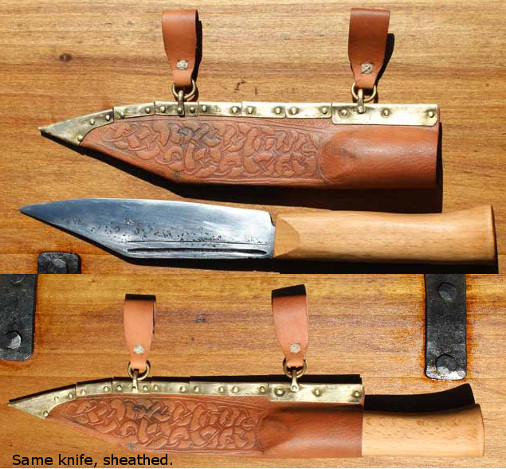 This reproduction is of an English Anglo-Saxon knife. I made this blade and scabbard for my second kit, supporting my Drangr assessment. The blade follows the proportions very closely, in both outline and profile. It is made of high quality steel, forged from round stock. The grip is European Beech and typical of seax design, it has no cross gaurd or pommel. It is assumed the proper use of a seax is as a slicing weapon, not a stabbing knife. Improper use would let the palm slip up onto the blade, leaving a nasty cut.
This reproduction is of an English Anglo-Saxon knife. I made this blade and scabbard for my second kit, supporting my Drangr assessment. The blade follows the proportions very closely, in both outline and profile. It is made of high quality steel, forged from round stock. The grip is European Beech and typical of seax design, it has no cross gaurd or pommel. It is assumed the proper use of a seax is as a slicing weapon, not a stabbing knife. Improper use would let the palm slip up onto the blade, leaving a nasty cut.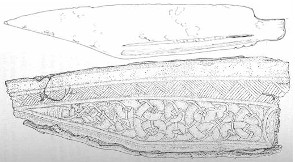
More details of the original artifacts.
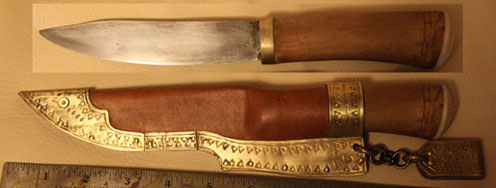 Here is the seax I carry for my Norwegian presentation. The design is a "broke back" one sharp edge style, with no cross guard, which typifies one of the seax sub-group styles. The applewood grip is capped by a disk of cow bone as a decorative element. The bolster at the blade end is brass. This is more a eating and self defence knife than an active combat weapon. It feels good in your hand... kind'da makes you feel all stabby!
Here is the seax I carry for my Norwegian presentation. The design is a "broke back" one sharp edge style, with no cross guard, which typifies one of the seax sub-group styles. The applewood grip is capped by a disk of cow bone as a decorative element. The bolster at the blade end is brass. This is more a eating and self defence knife than an active combat weapon. It feels good in your hand... kind'da makes you feel all stabby!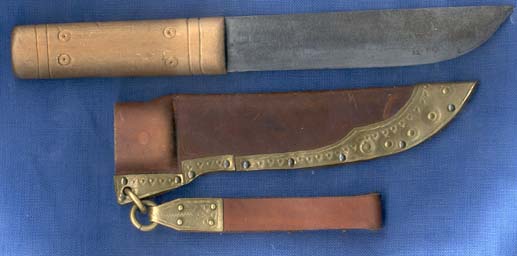 This knife, has been gifted to Kusi. The brass trim has traditional stamped decorations of ring dots and other patterns.
This knife, has been gifted to Kusi. The brass trim has traditional stamped decorations of ring dots and other patterns.
Here on the right are some knives for members of our group. The bottom right knife I keep as my own for camp rough work but be sure it holds a good sharp edge.
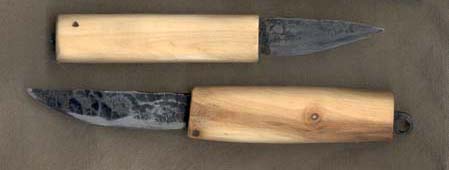
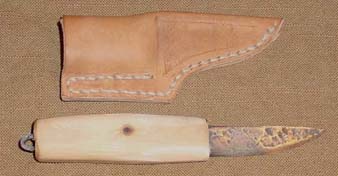
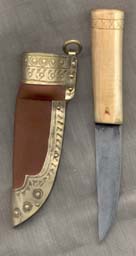 This knife is for Arnora, (To the left.) and is waiting for her to make her own chain mount, as that is what she does as our most talented chainmaille artist.
This knife is for Arnora, (To the left.) and is waiting for her to make her own chain mount, as that is what she does as our most talented chainmaille artist.
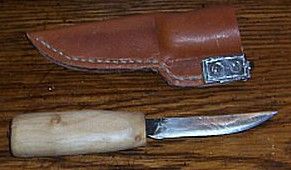 Many of these are blades made as gifts for Fjellborg members for acheivments in improving their "kits" or presentations in the course of their hobby and through their efforts in public education.
Many of these are blades made as gifts for Fjellborg members for acheivments in improving their "kits" or presentations in the course of their hobby and through their efforts in public education.

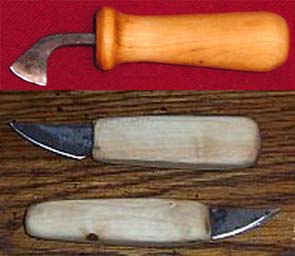 I made this tool on the right for Farman and his leather working. It works well for cutting curves in leather. The two below that one are two crafting knives, one for Farman and one for Arnora.
I made this tool on the right for Farman and his leather working. It works well for cutting curves in leather. The two below that one are two crafting knives, one for Farman and one for Arnora.
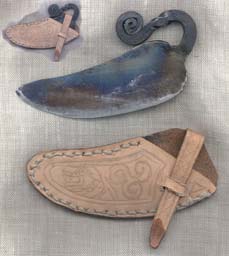
Then for something different, on the right, I made this Viking age razor in a similar pattern to a known Finnish razor. the little insert in the top left corner shows the razor safely tucked away in it's sheath. The blade is tempered to a hard yellow with the razor's back is a softer blue then the tang is annealed to gray.
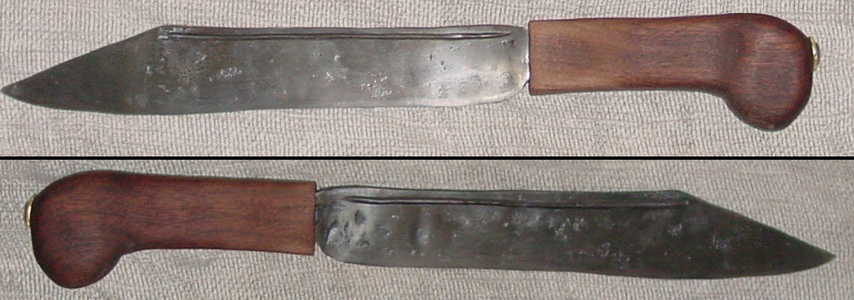 I've made many more of the small "camp knives" but more recently I made Rolan this Seax with a eleven inch blade. Rolan made the grip from walnut. The "rat tail" tang was peened over a bronze washer to hold the grip in place. You can see more of Rolan's kit by returning to the Gallery and clicking on his picture.
I've made many more of the small "camp knives" but more recently I made Rolan this Seax with a eleven inch blade. Rolan made the grip from walnut. The "rat tail" tang was peened over a bronze washer to hold the grip in place. You can see more of Rolan's kit by returning to the Gallery and clicking on his picture.
A question was raised, "Did the Vikings only have rough forged knives?" The answer is simply "no". But you can find all sorts of finely crafted and smooth ground, shiny seaxs and knives on the internet. If you are going to portray the culture of the time, you need to illustrate a cross section of the times, people and artifacts. People owned a variety of items that ranged from crudely worked to excellently crafted items. But BUYING obviously forged knives is not the thing you find in general internet searches. True, I could take more time grinding and polishing but that is not what I am intending to show. They are all made of high quality steel and hold an excellent edge.
Q -"Did the Vikings have access to steel? I thought steel wasn't invented until the industrial age?"
The Vikings had access to steel because alot of the iron they used had naturally occurring carbon infused in the metal. They actually worked hard to get rid of the carbon, thinking is was an impurity. As the levels of carbon infusion found in much of their iron was high, it was a problem they had to deal with. The smiths didn't understand the relationship carbon has in changing iron to steel, so many of their tools had inconsistent ratio's of carbon/iron. Better smiths had worked out methods to make better tools and weapons however they often believed that magic was effecting the process. So certain smiths and certain blades, attained similar reputations.